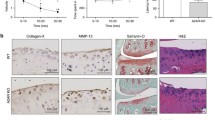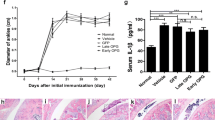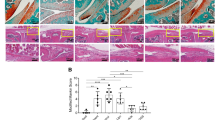Abstract
Recent studies have found that the inactivation of small hyaluronan (HA) fragments originating from native HA during inflammation reduced the inflammatory response in models of experimental arthritis. The stimulation of adenosine receptors A2A reduced inflammation by inhibiting NF-kB activation. The combination of both treatments was significantly more effective than either of the individual treatments. The aim of this study was to further investigate the effects of a combined treatment using the HA inhibitor Pep-1 and a selective A2AR agonist (CV-1808) on the structure and ultrastructure of the articular cartilage and on apoptosis in a model of collagen-induced arthritis (CIA) in mice. Arthritic mice were treated with Pep-1 and/or CV-1808 intraperitoneally daily for 20 days. At day 35, the hind limbs were processed for light microscopy (hematoxylin/eosin and Safranin-O-Fast Green) and for transmission and scanning electron microscopy. CIA increased IL-6, caspase-3 and caspase-7 mRNA expression and the related protein levels in arthritic articular cartilage, and significantly increased concentrations of Bcl-2-associated X protein (Bax), while B cell-lymphoma-2 protein (Bcl-2) was markedly reduced. The combined Pep-1/CV-1808 treatment significantly reduced CIA injury, particularly at the highest doses, demonstrated by the presence of Safranin-O-positive cartilage, with a smooth surface and normal chondrocytes in the superficial, intermediate and deep zones. Morphological data and histological scoring were strongly supported by the reduction in inflammation and apoptotic markers. The results further support the role of HA degradation and A2A receptors in arthritis.






Similar content being viewed by others
References
Abramson SB, Attur M, Amin AR, Clancy R (2001) Nitric oxide and inflammatory mediators in the perpetuation of osteoarthritis. Curr Rheumatol Rep 3:535–541
Almond A (2007) Hyaluronan. Cell Mol Life Sci 64:1591–1596
Almonte-Becerril M, Navarro-Garcia F, Gonzalez-Robles A, Vega-Lopez MA, Lavalle C, Kouri JB (2010) Cell death of chondrocytes is a combination between apoptosis and autophagy during the pathogenesis of osteoarthritis within an experimental model. Apoptosis 15:631–638
Asquith DL, Miller AM, McInnes IB, Liew FY (2009) Animal models of rheumatoid arthritis. Eur J Immunol 39:2040–2044
Bajaj S et al (2010) Protective effect of P188 in the model of acute trauma to human ankle cartilage: the mechanism of action. J Orthop Trauma 24:571–576
Bluml S, Redlich K, Smolen JS (2014) Mechanisms of tissue damage in arthritis. Semin Immunopathol 36:531–540
Brouckaert G et al (2004) Phagocytosis of necrotic cells by macrophages is phosphatidylserine dependent and does not induce inflammatory cytokine production. Mol Biol Cell 15:1089–1100
Campo GM, Avenoso A, Campo S, D’Ascola A, Traina P, Calatroni A (2009) Differential effect of molecular size HA in mouse chondrocytes stimulated with PMA. Biochim Biophys Acta 1790:1353–1367
Campo GM, Avenoso A, Campo S, D’Ascola A, Nastasi G, Calatroni A (2010a) Small hyaluronan oligosaccharides induce inflammation by both toll-like-4 and CD44 receptors in human chondrocytes. Biochem Pharmacol 80:480–490
Campo GM, Avenoso A, Campo S, D’Ascola A, Nastasi G, Calatroni A (2010b) Molecular size hyaluronan differently modulates toll-like receptor-4 in LPS-induced inflammation in mouse chondrocytes. Biochimie 92:204–215
Campo GM et al (2012a) Hyaluronan differently modulates TLR-4 and the inflammatory response in mouse chondrocytes. BioFactors 38:69–76
Campo GM, Avenoso A, D’Ascola A, Scuruchi M, Prestipino V, Calatroni A, Campo S (2012b) 6-Mer hyaluronan oligosaccharides increase IL-18 and IL-33 production in mouse synovial fibroblasts subjected to collagen-induced arthritis. Innate Immun 18:675–684
Campo GM et al (2012c) The stimulation of adenosine A2 receptor reduces inflammatory response in mouse articular chondrocytes treated with hyaluronan oligosaccharides. Matrix Biol 31:338–351
Campo GM et al (2012d) Adenosine A2A receptor activation and hyaluronan fragment inhibition reduce inflammation in mouse articular chondrocytes stimulated with interleukin-1β. FEBS J 279:2120–2133
Campo GM et al (2013) Combined treatment with hyaluronan inhibitor Pep-1 and a selective adenosine A2 receptor agonist reduces inflammation in experimental arthritis. Innate Immun 19:462–478
Cho YG, Cho ML, Min SY, Kim HY (2007) Type II collagen autoimmunity in a mouse model of human rheumatoid arthritis. Autoimmun Rev 7:65–70
Courtenay JS, Dallman MJ, Dayan AD, Martin A, Mosedale B (1980) Immunisation against heterologous type II collagen induces arthritis in mice. Nature 283:666–668
Elmore S (2007) Apoptosis: a review of programmed cell death. Toxicol Pathol 35:495–516
Ferraccioli G, Bracci-Laudiero L, Alivernini S, Gremese E, Tolusso B, De Benedetti F (2010) Interleukin-1β and interleukin-6 in arthritis animal models: roles in the early phase of transition from acute to chronic inflammation and relevance for human rheumatoid arthritis. Mol Med 16:552–557
Fredholm BB, IJzerman AP, Jacobson KA, Klotz KN, Linden J (2001) International Union of Pharmacology. XXV. Nomenclature and classification of adenosine receptors. Pharmacol Rev 53:527–552
Henzgen S, Petrow PK, Thoss K, Bräuer R (1996) Degradation of articular cartilage during the progression of antigen-induced arthritis in mice. A scanning and transmission electron microscopic study. Exp Toxicol Pathol 48:255–263
Holstein AF, Wulfhekel V (1971) Die semidünnschnitt-tecknik als Grundlage für eine cytologische Beurteilung der Spermatogenese des Menschen. Andrologie 5:65–69
Hughes LC, Archer CW, Ap Gwynn I (2005) The ultrastructure of mouse articular cartilage: collagen orientation and implications for tissue functionality. A polarised light and scanning electron microscope study and review. Eur Cell Mater 9:68–84
Ishihara K, Hirano T (2002) IL-6 in autoimmune disease and chronic inflammatory proliferative disease. Cytokine Growth Factor Rev 13:357–368
Jacobson KA (2009) Introduction to adenosine receptors as therapeutic targets. Handb Exp Pharmacol 193:1–24
Jiang D, Liang J, Noble PW (2011) Hyaluronan as an immune regulator in human diseases. Physiol Rev 91:221–264
Kouri JB, Lavalle C (2006) Do chondrocytes undergo “activation” and “transdifferentiation” during the pathogenesis of osteoarthritis? A review of the ultrastructural and immunohistochemical evidence. Histol Histopathol 21:793–802
Kühn K, D’Lima DD, Hashimoto S, Lotz M (2004) Cell death in cartilage. Osteoarthr Cartil 12:1–16
Maehara H et al (2010) Repair of large osteochondral defects in rabbits using porous hydroxyapatite/collagen (HAp/Col) and fibroblast growth factor-2 (FGF-2). J Orthop Res 28:677–686
Maldonado M, Nam J (2013) The role of changes in extracellular matrix of cartilage in the presence of inflammation on the pathology of osteoarthritis. Biomed Res Int 2013:284873. doi:10.1155/2013/284873
Manera C, Saccomanni G (2010) A2A receptor ligands: past, present and future trends. Curr Top Med Chem 10:902–922
McInnes IB, Schett G (2007) Cytokines in the pathogenesis of rheumatoid arthritis. Nat Rev Immunol 7:429–442
Mistry D, Oue Y, Chambers MG, Kayser MV, Mason RM (2004) Chondrocyte death during murine osteoarthritis. Osteoarthr Cartil 12:131–141
Mummert ME, Mohamadzadeh M, Mummert DI, Mizumoto N, Takashima A (2000) Development of a peptide inhibitor of hyaluronan-mediated leukocyte trafficking. J Exp Med 192:769–779
Noble PW (2002) Hyaluronan and its catabolic products in tissue injury and repair. Matrix Biol 21:25–29
Reynolds ES (1963) The use of lead citrate at high pH as an electron-opaque stain in electron microscopy. J Cell Biol 17:208–212
Rigoglou S, Papavassiliou AG (2013) The NF-kB signaling in osteoarthritis. Int J Biochem Cell Biol 45:2580–2584
Roach HI, Aigner T, Kouri JB (2004) Chondroptosis: a variant of apoptotic cell death in chondrocytes? Apoptosis 9:265–277
Rozario T, DeSimone DW (2010) The extracellular matrix in development and morphogenesis: a dynamic view. Dev Biol 341:126–140
Sitkovsky MV (2003) Use of the A(2A) adenosine receptor as a physiological immunosuppressor and to engineer inflammation in vivo. Biochem Pharmacol 65:493–501
Striz I, Brabcova E, Kolesar L, Sekerkova A (2014) Cytokine networking of innate immunity cells: a potential target of therapy. Clin Sci 126:593–612
Sullivan GW, Fang G, Linden J, Scheld WM (2004) Adenosine receptor activation improves survival in mouse models of endotoxemia and sepsis. J Infect Dis 189:1897–1904
Sun HB (2010) Mechanical loading, cartilage degradation, and arthritis. Ann NY Acad Sci 1211:37–50
Takahashi N, Tetsuka T, Uranishi H, Okamoto T (2002) Inhibition of the NF-kB transcriptional activity by protein kinase A. Eur J Biochem 269:4559–4565
Thiel M, Caldwell CC, Sitkovky MV (2003) The critical role of adenosine A2A receptors in downregulation of inflammation and immunity in the pathogenesis of infectious diseases. Microbes Infect 5:515–526
Thomas CM, Fuller CJ, Whittles CE, Sharif M (2007) Chondrocyte death by apoptosis is associated with cartilage matrix degradation. Osteoarthr Cartil 15:27–34
Zamli Z, Sharif M (2011) Chondrocyte apoptosis: a cause or consequence of osteoarthritis? Int J Rheum Dis 14:159–166
Acknowledgments
The authors thank Mr. Sebastiano Brunetto from the Department of Biomedical Sciences and Morphofunctional Images of the University of Messina for the technical assistance. This study was supported by a grant COFIN 2009 of the MIUR, Italy [Grant No. 20094C2H2M_003].
Conflict of interest
We declare that we have no conflict of interest.
Author information
Authors and Affiliations
Corresponding author
Additional information
Giuseppe M. Campo and Antonio Micali have contributed equally to this work.
Rights and permissions
About this article
Cite this article
Campo, G.M., Micali, A., Avenoso, A. et al. Inhibition of small HA fragment activity and stimulation of A2A adenosine receptor pathway limit apoptosis and reduce cartilage damage in experimental arthritis. Histochem Cell Biol 143, 531–543 (2015). https://doi.org/10.1007/s00418-014-1298-7
Accepted:
Published:
Issue Date:
DOI: https://doi.org/10.1007/s00418-014-1298-7




